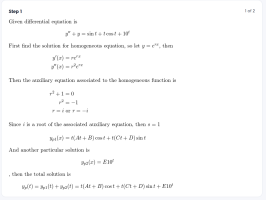Integrate
Junior Member
- Joined
- May 17, 2018
- Messages
- 111
If I understand the superposition principle of undetermined coefficients then that means we can take each part on the right hand side and solve for them using the method of undetermined coefficients.
We then can add them back together and be given a particular solution for the entire differential equation.
But
sometimes we don't need to do that?

In this problem we are to find the general form of the particular equation of this non homogeneous linear differential equation.
However the solution doesnt find the general form for sint. only tcost and 10^t
Why?
We then can add them back together and be given a particular solution for the entire differential equation.
But
sometimes we don't need to do that?

In this problem we are to find the general form of the particular equation of this non homogeneous linear differential equation.
However the solution doesnt find the general form for sint. only tcost and 10^t
Why?


